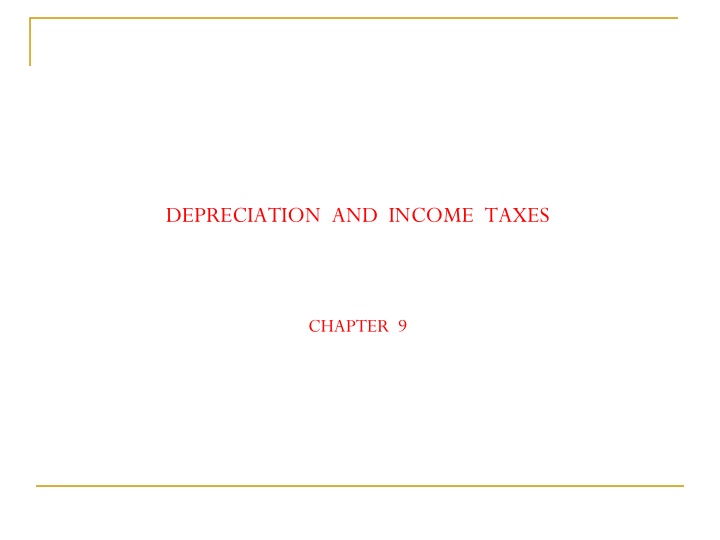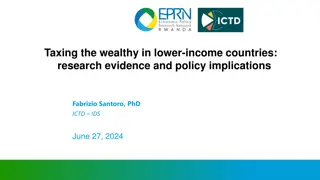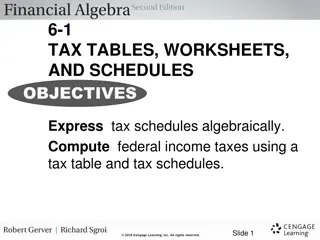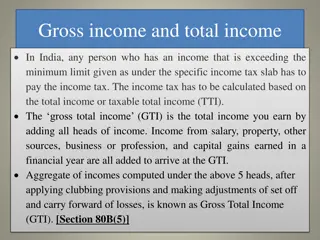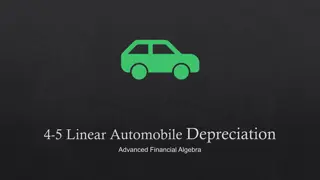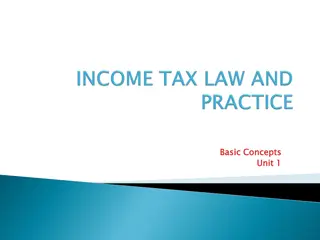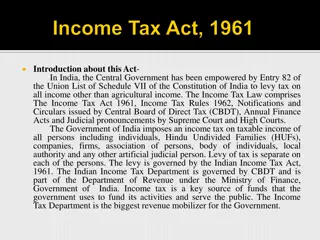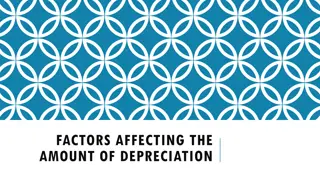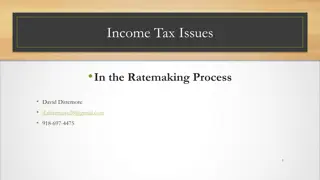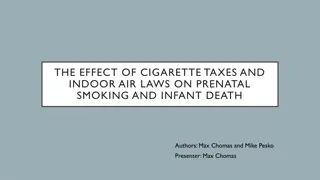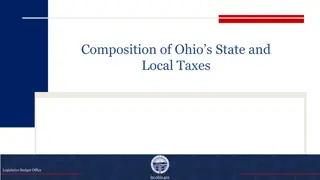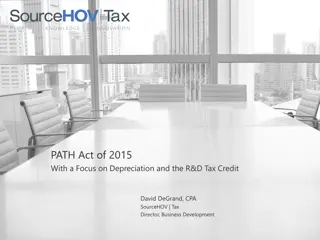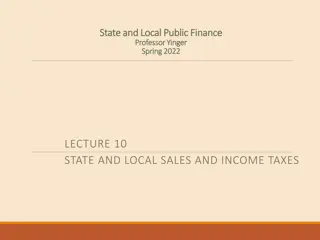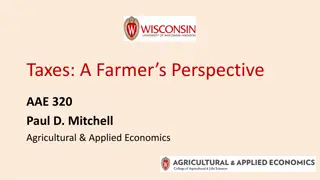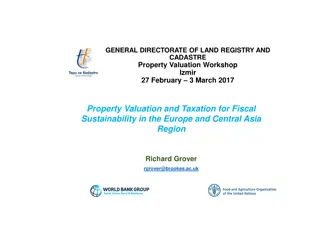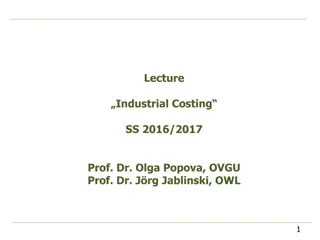Depreciation and Income Taxes - Chapter 9
Depreciation is the reduction in an asset's value over time, spread out to allocate costs. Learn about asset depreciation, tax implications, concepts, and its impact on business expenses. Understand how depreciation is used for tax purposes to reduce taxable income.
Uploaded on Mar 17, 2025 | 0 Views
Download Presentation

Please find below an Image/Link to download the presentation.
The content on the website is provided AS IS for your information and personal use only. It may not be sold, licensed, or shared on other websites without obtaining consent from the author.If you encounter any issues during the download, it is possible that the publisher has removed the file from their server.
You are allowed to download the files provided on this website for personal or commercial use, subject to the condition that they are used lawfully. All files are the property of their respective owners.
The content on the website is provided AS IS for your information and personal use only. It may not be sold, licensed, or shared on other websites without obtaining consent from the author.
E N D
Presentation Transcript
DEPRECIATION AND INCOME TAXES CHAPTER 9
Asset Depreciation Book Depreciation Tax Depreciation Corporate Taxes
WHAT IS DEPRECIATION? Definition:Loss of value for a fixed asset between two periods Example:Market values of a vehicle over 5 years End of Year Market Value Loss of Value D e p r e c i a t i o n 2007 $20,000 2008 $14,000 $6,000 2009 $10,000 $4,000 2010 $7,000 $3,000 2011 $5,000 $2,000 2012 $4,000 $1,000
Depreciation Concept Depreciation is a term used in accounting, economics, and finance to spread the cost of an asset over the period of several years. is the reduction in the value of an asset due to usage, passage of time, and technological outdatingor other factors. Economic Depreciation (Purchase Price Market Value) Economic losses due to both physical deterioration and technological obsolescence. Accounting Depreciation Systematic allocation (distribution) of the initial cost of an asset in parts over a time or decline in value over time and sometimes referred to more generally as asset depreciation.
Depreciation - Concept * Depreciation is a means of cost allocation. * It is not a method of valuation. * Depreciation involves: allocating the cost of tangible assets to expense in a systematic and rational manner to periods expected to benefit from use of assets 5
Depreciation and Expenses Expenses - subtracted from business revenues as they occur (time frame < one year). Labor Utilities Materials Insurance, etc. Depreciation - subtracted from business revenues over time as the asset is used up (applies to assets with > 1 year useful life). Machinery Installation costs 6
Depreciation for Tax Purposes Depreciable life - the period over which an asset is depreciated (recovery period). Depreciation is a non-cash cost - money does not change hands during the recovery period. (Note: The asset is already paid for or money has been borrowed and principal & interest payments are being made.) Depreciation is used to allocate an asset s loss of value over time Depreciation is deducted from revenue and reduces the taxable income of a business over time which produces a cash flow on an after tax-basis. 7
Factors to Consider in the process of an Asset Depreciation What is the cost of the asset? What is asset s value at the end of its useful life? What is the depreciable life of the asset? What method of depreciation do we choose?
What Can Be Depreciated? Depreciable property has the following characteristics 1. Assets must be used in business or held for production of income. 2. Assets must have a definite service (useful) life which must be longer than one year. 3. Assets must be wear out, become obsolete or loses value from natural causes. A qualifying asset for depreciation must satisfy all of the three conditions above.
1. Depreciable Property includes buildings, machinery, equipment, vehicles etc. and some intangible properties 2. Inventories are not depreciable property as they are held for sale to customers 3. If an asset has no definite service life, the asset can not be depreciated. For example LAND 4. However, any land improvements such as driveways, parking lots, lighting etc. have limited useful lives hence are subjected to capitalization (depreciation)
Example 9.1 Cost Basis of an asset represents the total cost that is claimed as an expense over an asset's life and generally includes the actual cost of an asset and all accompanying expenses, such as freight, site preparation, and installation. Cost of a new stamping machine (Invoice price) $22,700 Freight 525 Installation labor 1,350 Site preparation 2,125 Cost of Machine (Cost basis) $26,700
Useful life and salvage value How Long will an asset be useful to the company?... Asset Depreciation Range ADR (years) Assets Used Lower Limit Midpoint Life Upper Limit Office furniture, fixtures, and equipment 8 10 12 Information systems (computers) 5 6 7 Airplanes 5 6 7 Automobiles, taxis 2.5 3 3.5 Buses 7 9 11 Light trucks 3 4 5 Heavy trucks (concrete ready-mixer) 5 6 7 Railroad cars and locomotives 12 15 18 Tractor units 5 6 7 Vessels, barges, tugs, and water transportation system 14.5 18 21.5 Industrial steam and electrical generation 17.5 22 26.5 Manufacturer of electrical and non-electrical machinery 8 10 12 Manufacturer of electronic components, products, 5 6 7 Manufacturer of motor vehicles 9.5 12 14.5 Telephone distribution plant 28 35 42
Types of Depreciation Book Depreciation [financial report] Firms report depreciation and net income to investors / stockholders (such as in balance sheet or income statement) Tax Depreciation [Internal Revenue Service] In calculating income taxes for the IRS In engineering economics, we use depreciation in the context of tax depreciation Tax depreciation method allows firms to benefit from the tax advantages of depreciating assets.
Book Depreciation Methods Three different methods can be used to calculate the periodic depreciation allowances for financial reporting. Types of Depreciation Methods: Straight-Line Method Declining Balance Method Unit Production Method
Straight Line (SL) Method Principle A fixed asset is an asset that provides its services in a uniform fashion. That is, the asset provides equal amount of service in each year of its useful life. Formula Annual Depreciation Dn = (I S) / N and constant for all n. Book Value Bn=I n (D) where I= cost basis S = Salvage value N = depreciable life
Example 9.2 Straight Line Method Consider the following data on an automobile, compute the annual depreciation allowances and resulting book values using the straight-line method. I = $10,000 N = 5 Years S = $2,000 D = (I - S)/N Find: Dn and Bn n Dn Bn 0 $10,000 1 1,600 8,400 2 1,600 6,800 3 1,600 5,200 n 4 1,600 3,600 5 1,600 2,000
Declining Balance Method (DBM) Principle: A fixed asset is providing its service in a decreasing fashion over time. DBM calculating depreciation allocates a fixed fraction and it is obtained from SL depreciation rate (1/N) as a basis: = (1/N) x (multiplier). Most commonly used multipliers in the USA are 1.5 DB or 2.0 DDB Annual Depreciation = = D B 1 n { 1 ( ) } I 1 n n Book Value = n where 0 < < 2(1/N) 1 ( ) B I Note: if is chosen to be the upper bound, = 2(1/N), we call it a 200% DB or double declining balance method.
Example 9.3 Declining Balance (DB) Depreciation Asset: Invoice Price ...... $9,000 Freight .... 500 Installation ...... 500 Depreciation Base ........ $10,000 Salvage Value ......................................... 2,000 Depreciation Depreciable life 200% DDB 5 years SL Dep. Rate = 1/5 a (DDB rate) = (200%) (SL rate) = 0.40
= n 1 ( ) B I S = $2,000 = D B 1 n n End of Year Depreciation Book Value 1 0.4($10,000) = $4,000 $10,000 - $4,000 = $6,000 2 0.4(6,000) = 2,400 6,000 2,400 = 3,600 3 0.4(3,600) = 1,440 3,600 1,440 = 2,160 4 0.4(2,160) = 864 $160 2,160 160 = 2,000 Adjusting to salvage value 5 0 2,000 0 = 2,000 Total = $8,000 Note: Tax law does not permit to depreciate assets below their salvage values.
Example 9.4 Declining Balance (DB) Depreciation Asset: Invoice Price ...... $9,000 Freight ... 500 Installation ...... 500 Depreciation Base ........ .$10,000 Salvage Value .............................................. 0 Depreciation Depreciable life 200% DDB 5 years SL Dep. Rate = 1/5 a (DDB rate) = (200%) (SL rate) = 0.40
Example 9.4 Declining Balance (DB) with conversion to Straight Line Depreciation (Bn > S) Suppose the asset given in example 9.3 has a zero salvage value instead of $2,000 (a) Without switching (b) With switching to SL Book Value $6,000 3,600 2,160 1,296 778 Book n 1 2 3 4 5 Depreciation 10,000(0.4) = 4,000 6,000(0.4) = 2,400 3,600(0.4) = 1,440 2,160(0.4) = 864 1,296(0.4) = 518 n 1 2 3 4 5 Depreciation Value 10,000/5 = 2,000 < 4,000 $6,000 6,000/4 = 1,500 < 2,400 3,600/3 = 1,200 < 1,440 2,160/2 = 1,080 > 864 1,080/1 = 1,080 > 518 3,600 2,160 1,080 0 Note: Without switching, we have not depreciated the entire cost of the asset and thus have not taken full advantage of depreciation s benefits. The rule is; if DB depreciation in any year is less than (or equal to) the depreciation amount calculated by SL, switch to and remain with the SL method for the duration of the asset s depreciable life.
Units-of-Production Method Principle The number of service units will be consumed in that period. Formula Annual Depreciation Dn = Service units consumed for year ( I S ) total service units
Example 9.5 Units-of-Production Depreciation A truck for hauling coal has an estimated net cost of $55,000 and is expected to give service for 250,000 miles, resulting in $5,000 a salvage value. Compute the allowed depreciation amount for the truck usage of 30,000 miles Find: Depreciation amount this year Solution: 30,000($55,000 250,000 3 ($50,000) 25 $6,000 Dep = $5,000) = =
Depreciation Methods: Example A corporation buys a truck on January 1, 2000. Information relating to the truck is as follows: Cost, $34,000 Estimated service life, 5 years (or 60,000 miles) Salvage value end of five years or use, $4,000 Actual miles driven: 20,000 miles (in 2000); 15,000 miles (in 2001) 24
Straight-line method 1. Depreciable base = $34,000 less $4,000 = $30,000 2. Annual depreciation = $30,000 / 5 years = $6,000 3. Depreciation Schedule: (years 1 and 2) Book Depreciation (beg) $34,000 $6,000 $28,000 $6,000 $22,000 $6,000 $16,000 $6,000 $10,000 $6,000 Year 1 2 3 4 5 Accumulated Depreciation end of year $6,000 $12,000 $18,000 $24,000 $30,000 Book value $28,000 $22,000 $16,000 $10,000 $4,000 ===0 25
Activity/Production Unit method (unit = mile) 1. Depreciable base = $34,000 less $4,000 = $30,000 2. Depreciation per mile = $30,000 / 60,000 = $0.50 3. Depreciation (2000) = $0.50 * 20,000 miles = $10,000 4. Depreciation Schedule: (years 1 and 2) Book Depreciation (beg) $34,000 $10,000 $24,000 $ 7,500 Year 1 2 Accumulated Depreciation $10,000 $17,500 Book value end of year $24,000 $16,500 26
Double Declining balance method 1. Rate of depreciation = 2 * (1/5) = 0.40 2. Depreciation (2000) = $34,000 * 0.40 = $ 13,600 Depreciation (2001) = $20,400 * 0.40 = $ 8,160 Depreciation (2002) = $12,240 * 0.40 = $ 4,896 Depreciation (2003) = $ 7,344 * 0.40 =$ 2937+407 = $ 3,344 Depreciation (2004) = none Total depreciation taken = $ 30,000 Depreciation = Rate of depreciation * Book Value at t-1 period 27
Double declining balance method 3. Depreciation Schedule Year Book (beg) Depreciation Accumulated Depreciation Book value end of year 1 2 3 4 5 $34,000 $13,600 $20,400 $ 8,160 $12,240 $ 4,896 $ 7,344 $ 3,344 $ 4,000 $ none $13,600 $21,760 $ 26,656 $ 30,000 $ 30,000 $20,400 $12,240 $ 7,344 $ 4,000 $ 4,000 28
History of Tax Depreciation Methods Purpose:compute income taxes for the IRS Assets placed in service prior to 1981 Use book depreciation methods (SL, DB) Assets placed in service from 1981 to 1986 Use ACRS (Accelerated Cost Recovery System) Table Assets placed in service after 1986 Use MACRS (Modified ACRS) Table
Modified Accelerated Cost Recovery Systems (MACRS) Personal Property: (movable property, includes assets such as machinery, vehicles, equipment, furniture, and similar items) Depreciation method based on DB method switching to SL Half-year convention Zero salvage value Real Property: (includes houses and land) are classified into two categories: 1. residential rental property and 2. commercial building or properties SL Method Mid-month convention Zero salvage value
MACRS Property Classifications (ADR = Asset Depreciation Range) Recovery Period ADR Midpoint Class Applicable Property 3-year Special tools for manufacture of plastic products, fabricated metal products, and motor vehicles. Personal ADR 4 Property 5-year Automobiles, light trucks, high-tech equipment, equipment used for R&D, computerized telephone switching systems 4 10 ADR 7-year Manufacturing equipment, office furniture, fixtures 10 16 ADR 10-year Vessels, barges, tugs, railroad cars 16 20 ADR 15-year Waste-water plants, telephone- distribution plants, or similar utility property. 20 25 ADR 25 ADR 20-year Municipal sewers, electrical power plant. 27.5-year Residential rental property Real 39-year Nonresidential real property including elevators and escalators Property
Example MACRS Depreciation Asset cost = $10,000 Property class = 5 year MACRS DB method = Half year convention, zero salvage value, 200% DDB switching to SL 20% 32% 19.20% 11.52% 11.52% 5.76% $2000 $3200 $1920 $1152 $1152 $576 Full Full Full Full 1 2 3 4 5 6 Half-year Convention
How to Determine Accounting Profit Item Gross Income Expenses Cost of goods sold (revenues) Depreciation Operating expenses Taxable income Income taxes Net income (Accounting Profit)
Example Net Income within a year A company buys a numerically control (NC) machines for $28,000 (year Zero) and uses it for five years, after which time it is scrapped. The allowed depreciation deduction during the first year is $4,000, as the equipment falls into the seven year MACRS property category. (The first year depreciation rate is 14.29%). Suppose the company estimates the following revenues and expenses, including the depreciation for the first operating year. Gross income = $50,000 Cost of goods sold = $20,000 Depreciation on NC machine = $4,000 Operating expenses = $6,000 If the company pays taxes at the rate of 40% on its taxable income, what is the net income from the project during the first year?
Example of Net Income within a year Item Amount Gross income (revenue) $50,000 Expenses Cost of goods sold Depreciation Operating expenses 20,000 4,000 6,000 Taxable income 20,000 Taxes (40%) 8,000 Net income $12,000
Capital Expenditure versus Depreciation Expenses ( 7 - year MACRS property ) 1 2 3 4 5 6 7 8 0 Capital expenditure (actual cash flow) $28,000 1(14.29) 2 (24.49) 3 (17.49) 4 (12.49) 5 (8.93) 6 (8.92) 7(8.93) 8 (4.46) 0 $1,250 $2,500 $2,500 $3,500 $2,500 $4,000 $4,900 $6,850 Allowed depreciation expenses (not cash flow)
Example Cash Flow from Operation versus Net Income Item Income Cash Flow Gross income (revenue $50,000 $50,000 Expenses Cost of goods sold Depreciation Operating expenses 20,000 4,000 6,000 -20,000 -6,000 Taxable income 20,000 Taxes (40%) 8,000 -8,000 Net income $12,000 Net cash flow from operation $16,000
U.S. Corporate Tax Schedule Marginal tax rate is defined as the rate applied to the last dollar of income. Taxable income Tax rate Tax computation 0-$50,000 15% $0 + 0.15(D) $50,001-$75,000 25% $7,500 + 0.25 (D) $75,001-$100,000 34% $13,750 + 0.34 (D) $100,001-$335,000 39% $22,250 + 0.39 (D) $335,001-$10,000,000 34% $113,900 + 0.34 (D) $10,000,001-$15,000,000 35% $3,400,000 + 0.35 (D) $15,000,001-$18,333,333 38% $5,150,000 + 0.38 (D) $18,333,334 and Up 35% $6,416,666 + 0.35 (D) (D) denotes the taxable income in excess of the lower bound of each tax bracket
Marginal and Effective (Average) Tax Rate for a Taxable Income of $16,000,000 Taxable income Marginal Tax Rate Amount of Taxes Cumulative Taxes First $50,000 15% $7,500 $7,500 Next $25,000 25% 6,250 13,750 Next $25,000 34% 8,500 22,250 Next $235,000 39% 91,650 113,900 Next $9,665,000 34% 3,286,100 3,400,000 Next $5,000,000 35% 1,750,000 5,150,000 Remaining $1,000,000 38% 380,000 $5,530,000 Average tax rate =$5,530,000 = 34 56% . $16, 000 000 ,
Example Corporate Income Taxes Facts: Capital expenditure $290,000 (allowed depreciation) $58,000 Gross Sales revenue $1,250,000 Expenses: Cost of goods sold $840,000 Leasing warehouse $20,000 Question: Taxable income?
Taxable income: Gross income - Expenses: $1,250,000 (cost of goods sold) $840,000 (depreciation) (leasing expense) $20,000 $58,000 Taxable income $332,000 Income taxes: Taxable income Marginal Tax Rate Amount of Taxes Cumulative Taxes First $50,000 15% $7,500 $7,500 $25,000 25% 6,250 13,750 $25,000 34% 8,500 22,250 $232,000 39% 90,480 112,730
Average tax rate: Total taxes = $112,730 Taxable income = $332,000 Average tax rate =$112,730 $332,000 = 33 95% . Marginal tax rate: Tax rate that is applied to the last dollar earned 39%
Taxable Gains (or Losses) are defined as the differences between the salvage value and the book value. Case 1:Salvage value < Cost basis: gains (losses) = salvage value book value ordinary gains (depreciation recapture) Case 2: Salvage value > Cost basis: gains = salvage value book value + (cost basis book value) = (salvage value - cost basis) capital gains ordinary gains
Capital Gains and Ordinary Gains Capital gains Total gains Ordinary gains or depreciation recapture Cost basis Book value Salvage value
Disposal of a MACRS Property and Its Effect on Depreciation Allowances
Example 9.9 A Drill press: $230,000 Gains or Losses on Depreciable Asset Project year: 3 years MACRS: 7-year property class Salvage value: $150,000 at the end of Year 3 Total Dep. = 230,000(0.1429 + 0.2449 + 0.1749/2) = $109,308 Book Value = 230,000 -109,308 = $120,692 Ordinary Gains = Salvage Value - Book Value = $150,000 - $120,692 = $29,308 Gains Tax (34%) = 0.34 ($29,308) = $9,965 Net Proceeds from sale = $150,000 - $9,965 = $140,035
Case 2: S = $120,692 Case 3: S = $100,000 Total Dep. = 230,000(0.1429 + 0.2449 + 0.1749/2) = $109,308 Book Value = 230,000 -109,308 = $120,692 Ordinary Gains = Salvage Value - Book Value = $100,000 - $120,692 = -$20,692 Gains Tax or Tax credit (34%) = 0.34 (-$20,692) = - $7,035 Net Proceeds from sale = $100,000 (- $7,035) = $107,035.28
